Imagine waking up to shimmering emerald lakes cradled by towering peaks, hiking trails that wind up to tea houses in the clouds, and cozy alpine towns radiating charm. Banff National Park is where adventure meets tranquility, offering an unforgettable escape for both thrill-seekers and nature enthusiasts. This guide takes you through our carefully crafted 7-day Banff road trip, blending awe-inspiring drives, exhilarating hikes, and serene moments for the ultimate Rocky Mountain getaway.
Note: This guide is tailored for summer travelers, highlighting the best activities and experiences during the warmer months. It’s also applicable for late spring and early autumn visits, when the landscapes remain stunning, and the crowds thin out. However, winter activities like skiing and snowboarding are not covered.
Getting to Know Banff: A Pristine Wilderness Awaits
Why Visit Banff?
Nestled in the heart of the Canadian Rockies, Banff National Park is a natural treasure and Canada’s first national park, established in 1885. Covering over 6,641 square kilometers, Banff’s dramatic landscapes include rugged peaks, turquoise glacial lakes, and thriving wildlife. It’s a paradise for those seeking adventure, offering activities like hiking, skiing, kayaking, and wildlife spotting. Beyond its natural wonders, the park’s vibrant townsites and rich history add cultural depth to its breathtaking beauty.
Top Attractions in Banff National Park:
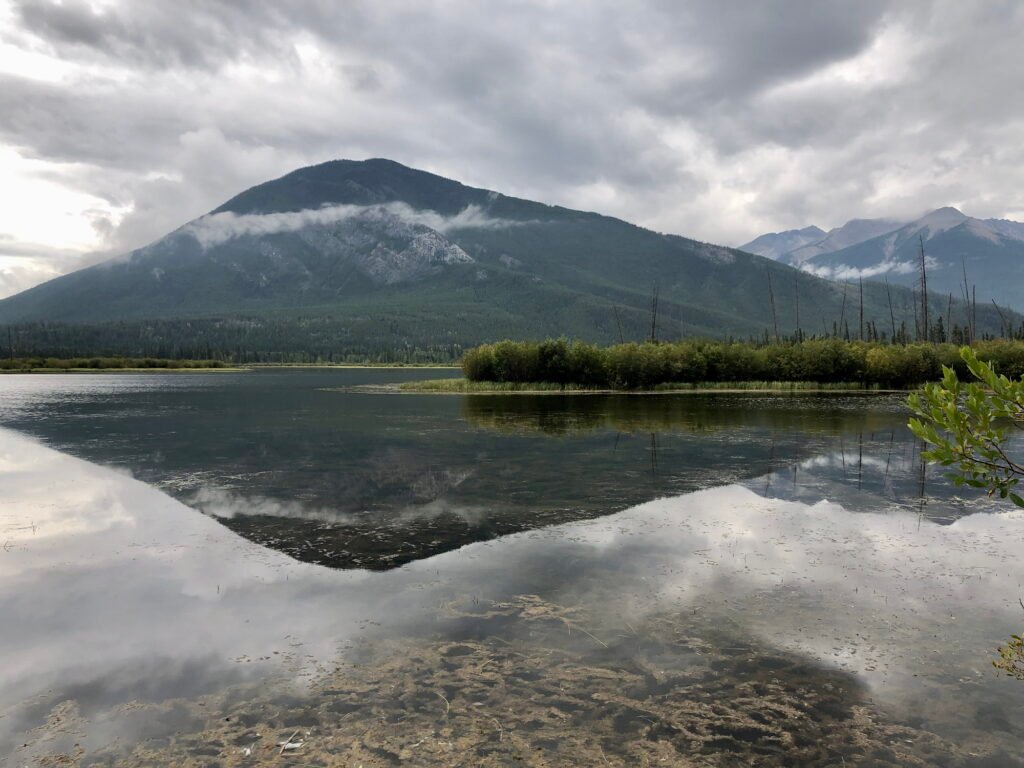


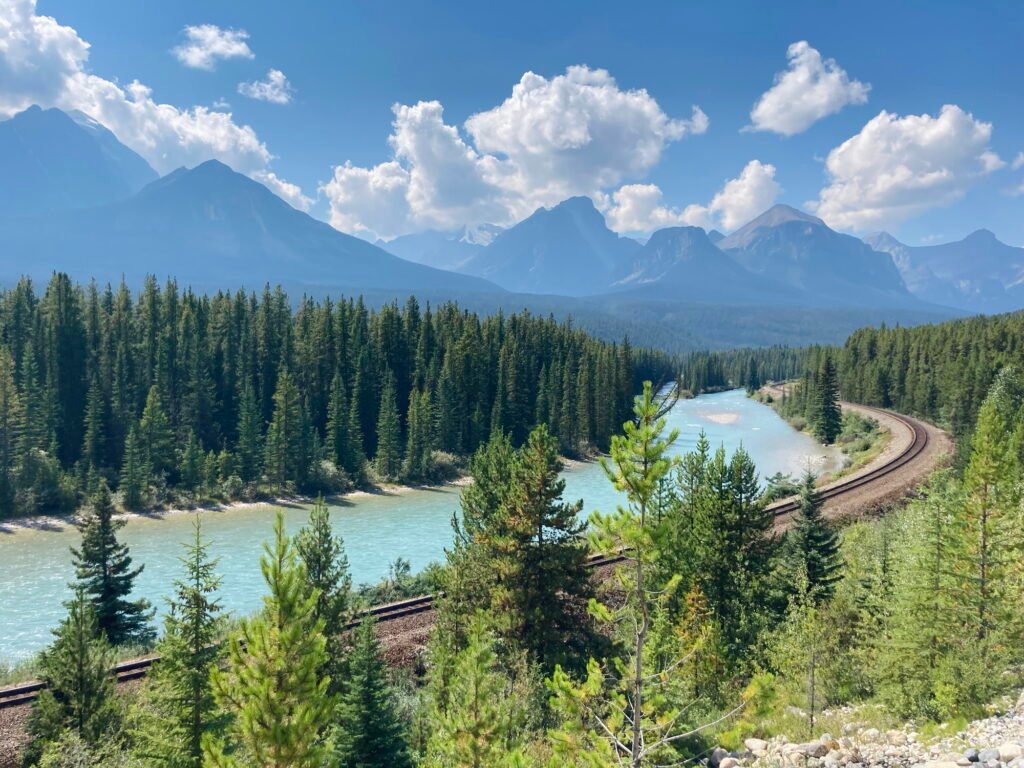
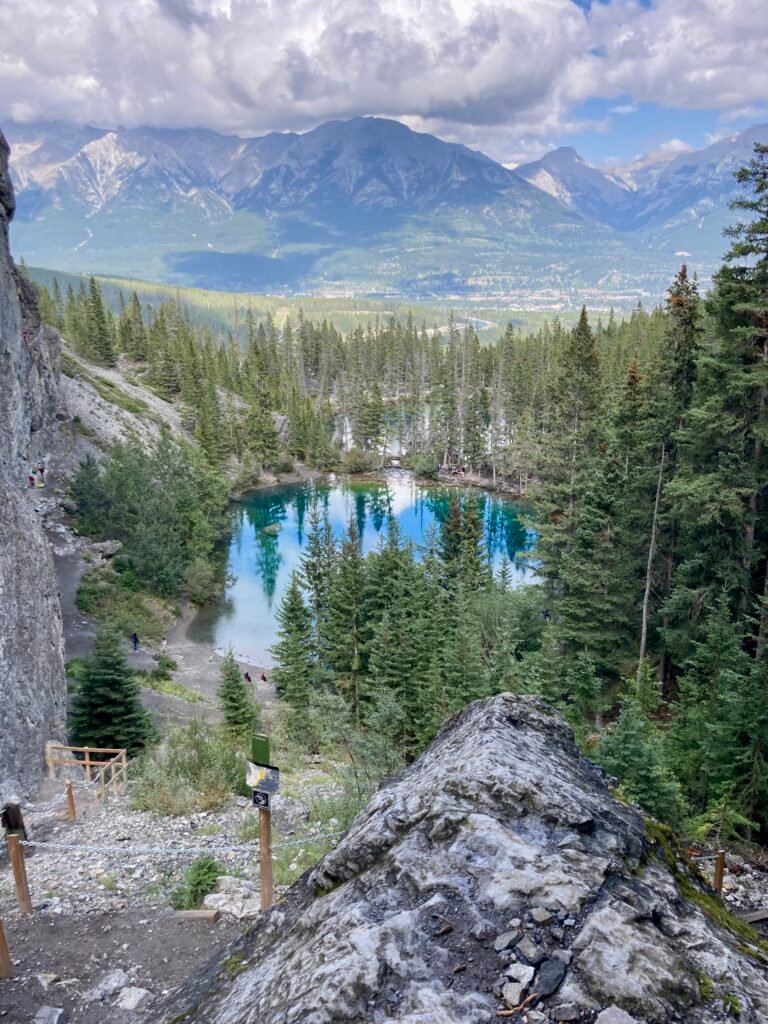




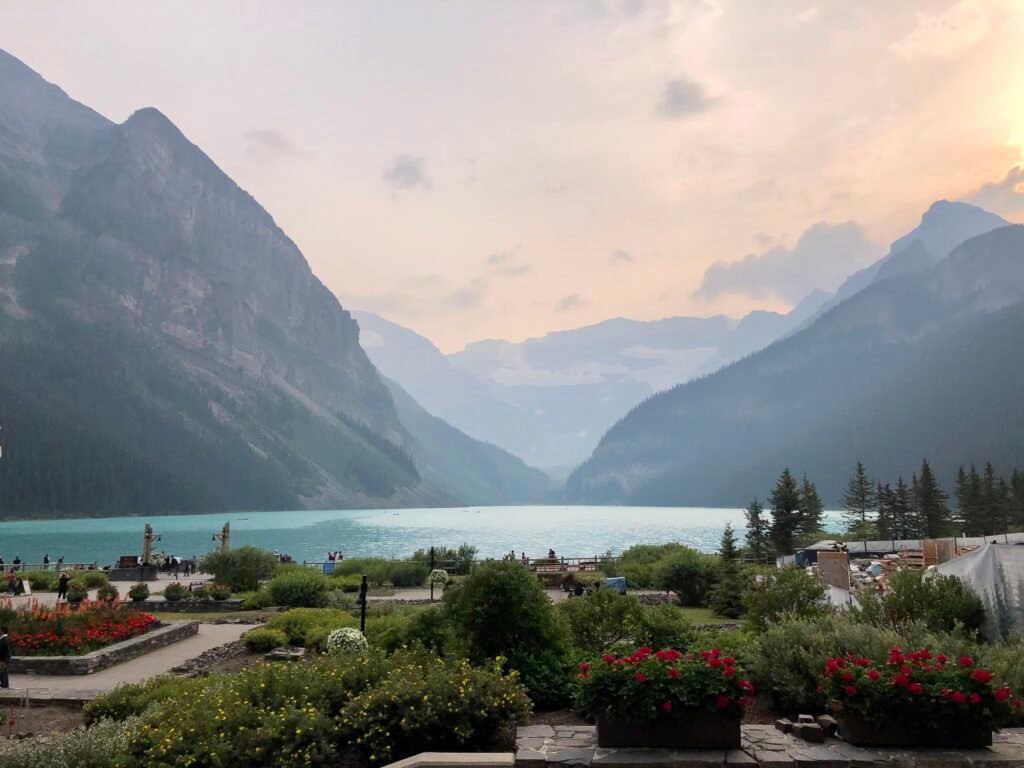
Location and Accessibility
Banff is nestled in the heart of Alberta, Canada, approximately 128 kilometers (80 miles) west of Calgary. The closest airport is Calgary International Airport, just 144 kilometers (90 miles) east of the park. From the airport, travelers can choose between rental cars, public transit, or shuttle services to reach Banff, making it an accessible destination for all.
For those seeking the ultimate experience, renting a car and embarking on a road trip is, in our opinion, the best way to immerse yourself in Banff’s breathtaking landscapes. Driving in Banff is easy and enjoyable thanks to well-maintained roads, clear signage, and developed infrastructure. Local drivers are polite and follow the rules, creating a stress-free environment for visitors exploring this stunning region. With the freedom of the open road, you’ll be able to savor every scenic drive, hidden gem, and iconic view that makes Banff unforgettable.
Geological Origins
Banff’s iconic scenery is the result of millions of years of geological transformation. The Rockies were formed from ancient sedimentary rocks pushed eastward over younger rock layers during mountain-building events between 80 and 55 million years ago. Over time, glacial activity carved the terrain, sculpting the valleys, peaks, and lakes we admire today. These timeless formations are a testament to nature’s powerful artistry.
Climate and Best Time to Visit
Banff’s subarctic climate brings distinct seasons, each offering unique opportunities for exploration. This guide focuses on visiting during the summer months (June to August) and the shoulder seasons of late spring or early autumn. These times are ideal for hiking, sightseeing, and water activities, with mild temperatures and vibrant landscapes.
- Summer (June to August): Perfect for outdoor adventures, with temperatures ranging from 7°C to 22°C (45°F to 72°F). Expect long daylight hours, lush greenery, and bustling activity.
- Spring and Fall: Cooler weather, fewer crowds, and beautiful seasonal transitions make these quieter periods a great alternative to summer.
- Winter (November to March): While Banff transforms into a snowy wonderland for skiing and snowboarding, this guide does not cover winter activities.
Safety and Visitor Information
Banff is a safe and welcoming destination for travelers, offering a well-maintained environment for exploration. However, respecting local wildlife is crucial—always maintain a safe distance and store food securely to avoid attracting animals. Before embarking on hikes or outdoor activities, check trail conditions and weather forecasts to ensure a smooth and enjoyable experience.
English and French are the official languages in Banff, and the local currency is the Canadian Dollar (CAD). Credit cards are widely accepted, making transactions convenient for international visitors.
Where to Stay When Visiting Banff National Park
Choosing the right place to stay can make all the difference in your Banff National Park adventure. With a variety of accommodations ranging from luxurious resorts to cozy cabins, you’ll find options to suit every budget and preference. Here are some of the best areas to consider:
1. Banff Town
Banff Town is the heart of the park and a convenient base for exploring the surrounding attractions. Staying here means easy access to shops, restaurants, and landmarks like Bow Falls and the Banff Gondola. Accommodations range from budget-friendly motels to upscale hotels like the Fairmont Banff Springs, often referred to as the “Castle in the Rockies.” If you love being at the center of the action, Banff Town is a great choice.
2. Canmore
Located just outside the park boundary, Canmore offers a quieter alternative to Banff Town. It’s perfect for those looking for a more local and laid-back vibe while still being within a 30-minute drive of key attractions. With charming Airbnbs, boutique hotels, and mid-range lodges, Canmore also tends to be more budget-friendly than Banff. Plus, the stunning mountain views in every direction make it an unforgettable place to stay.
3. Lake Louise Village
For unparalleled proximity to iconic attractions like Lake Louise, Moraine Lake, and the Plain of Six Glaciers Trail, consider staying in Lake Louise Village. The legendary Fairmont Château Lake Louise offers luxury accommodations with unmatched lakefront views, while smaller inns and lodges such as Paradise Lodge & Bungalows cater to mid-range budgets. Staying here allows you to beat the crowds and enjoy early mornings or evenings at these world-famous lakes.
4. Columbia Icefield Area
If you’re planning to explore the northern attractions of Banff National Park, including the Columbia Icefield and the breathtaking Icefields Parkway, the Glacier View Lodge is an excellent choice. Located directly across from the Columbia Icefield, this lodge offers unparalleled proximity to the glacier and provides a cozy, comfortable stay with stunning views of the surrounding landscapes. Staying here allows you to fully immerse yourself in the beauty of this remote area while eliminating long drives, making it a convenient and memorable option.
5. Campsites
For travelers looking to fully immerse themselves in Banff’s natural beauty, the park offers a range of well-maintained campsites nestled in stunning locations. Campgrounds like Tunnel Mountain Village provide the perfect opportunity to sleep under the stars, with the Rockies as your backdrop. Whether you’re traveling with an RV or pitching a tent, Banff’s campgrounds offer a rustic yet rewarding way to experience the park up close. Be sure to book early, as campsites are highly sought after during peak seasons.
Our Recommended 7-Day Banff Summer Road Trip Itinerary
Now that you’ve had a glimpse of Banff’s history and natural wonders, it’s time to hit the road and dive into the adventure. This 7-day Banff Road Trip Itinerary is your perfect guide to exploring the best of Banff, blending heart-pumping hikes, serene lakeside moments, and the alpine beauty that makes this destination so iconic. Designed with first-time visitors in mind, it’s your ticket to discovering Banff’s treasures without feeling rushed.
7-Day Banff Road Trip for First-time Visitors:
- Day 1: Arrival and Banff Town
- Day 2: Banff Gondola and Johnston Canyon
- Day 3: Lake Minnewanka and Grassi Lakes
- Day 4: Moraine Lake and Emerald Lake
- Day 5: Lake Louise to Columbia Glacier
- Day 6: Columbia Icefield and Icefields Parkway
- Day 7: Back to Calgary and Farewell
To make your journey smoother, we’ve included a custom map with all the key stops from this itinerary. Just click, navigate, and let the Rockies take care of the rest. Ready? Let’s hit the road and explore Banff’s best-kept secrets and must-see wonders!
Day 1: Arrival and Banff Town
Highlights: Arrival, Banff Town, Cascade of Time Garden, Vermilion Lakes, Canmore.
Morning:
We began our adventure by flying into Calgary, the gateway to the Canadian Rockies. With a well-connected airport and proximity to Banff (1.5-hour drive), Calgary makes for an ideal starting point.
Afternoon:
After landing around noon, we picked up our rental car and made a quick stop at T&T Supermarket, a popular Asian grocery store, to grab lunch and stock up on snacks and groceries. This was a budget-friendly move, as food prices inside Banff National Park are generally higher.
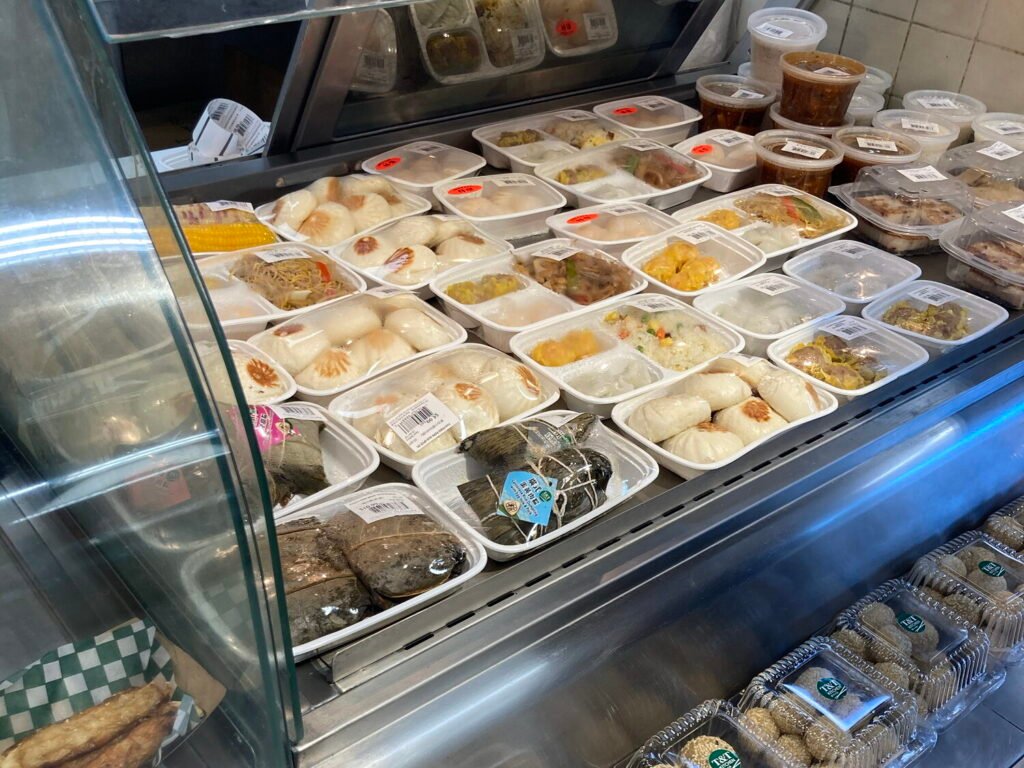
By mid afternoon, we left Calgary and headed toward Canmore (1hr drive), a picturesque town just 30 minutes from Banff. Surrounded by majestic mountains, Canmore offers a more tranquil, local atmosphere compared to bustling Banff Town, along with more affordable accommodations. We stayed at a centrally located Airbnb, which became our base for the next three days.
After checking in, we head out to Banff Town and spent the rest of the afternoon exploring there. Highlights included:
- Strolling leisurely along Banff’s lively main streets lined with charming shops and cozy cafes.
- Visiting the Cascade of Time Garden, a beautifully manicured space surrounded by towering mountain ranges.
- Exploring the serene Vermilion Lakes, where mountain reflections on the water were truly mesmerizing.
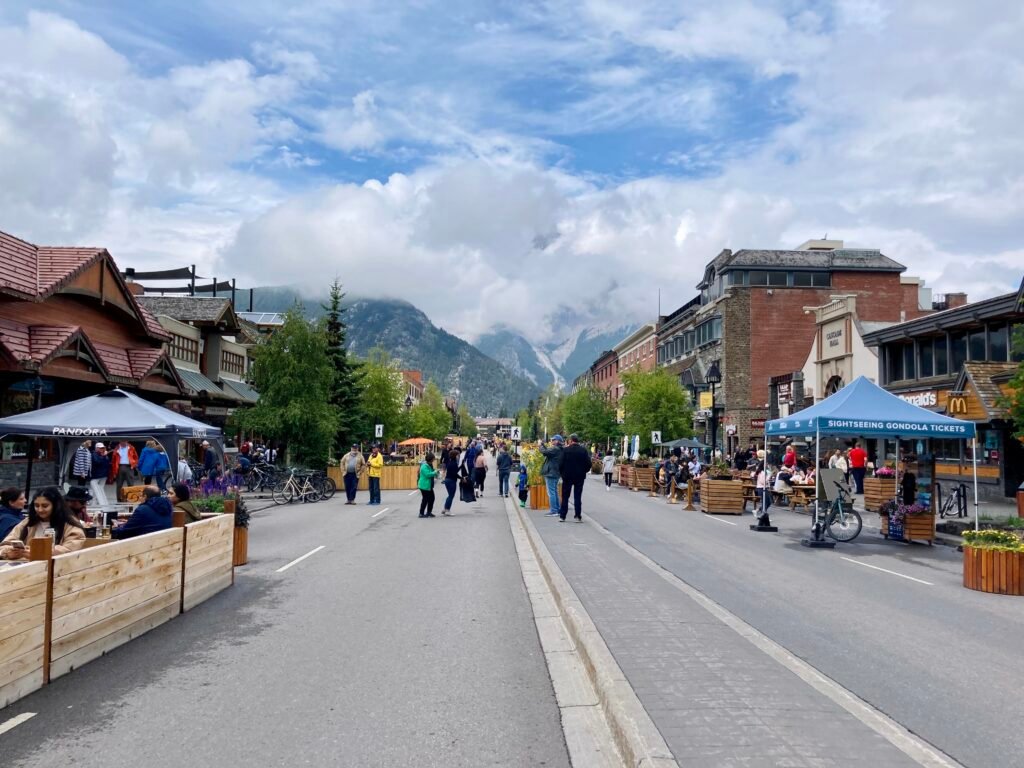
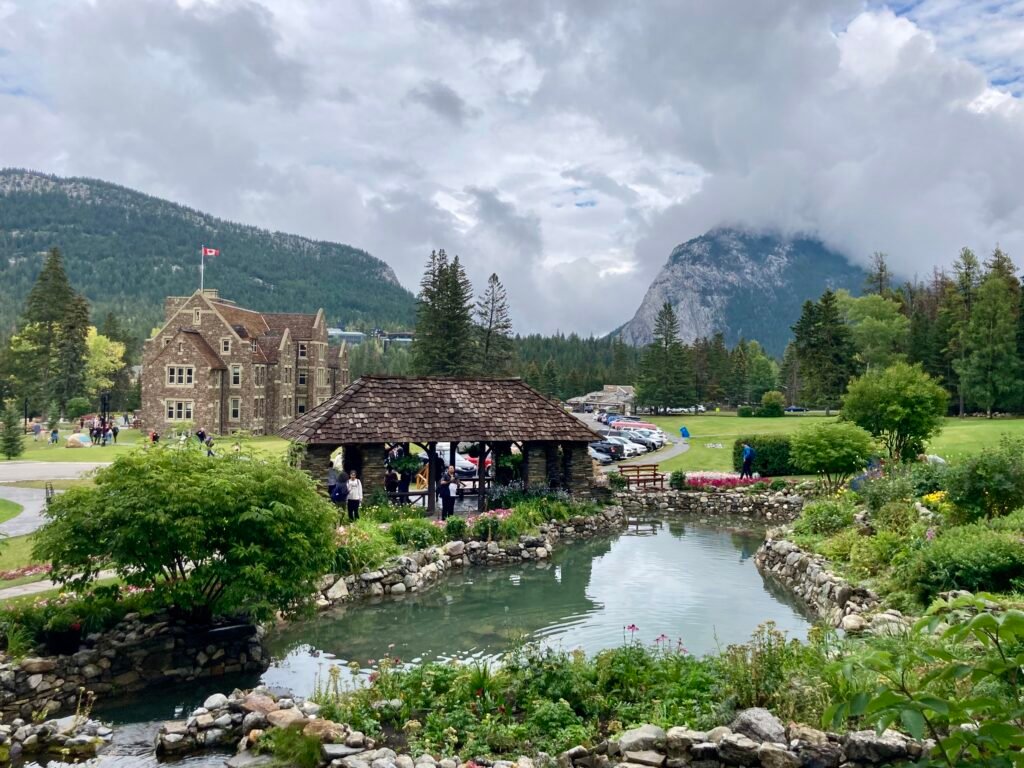
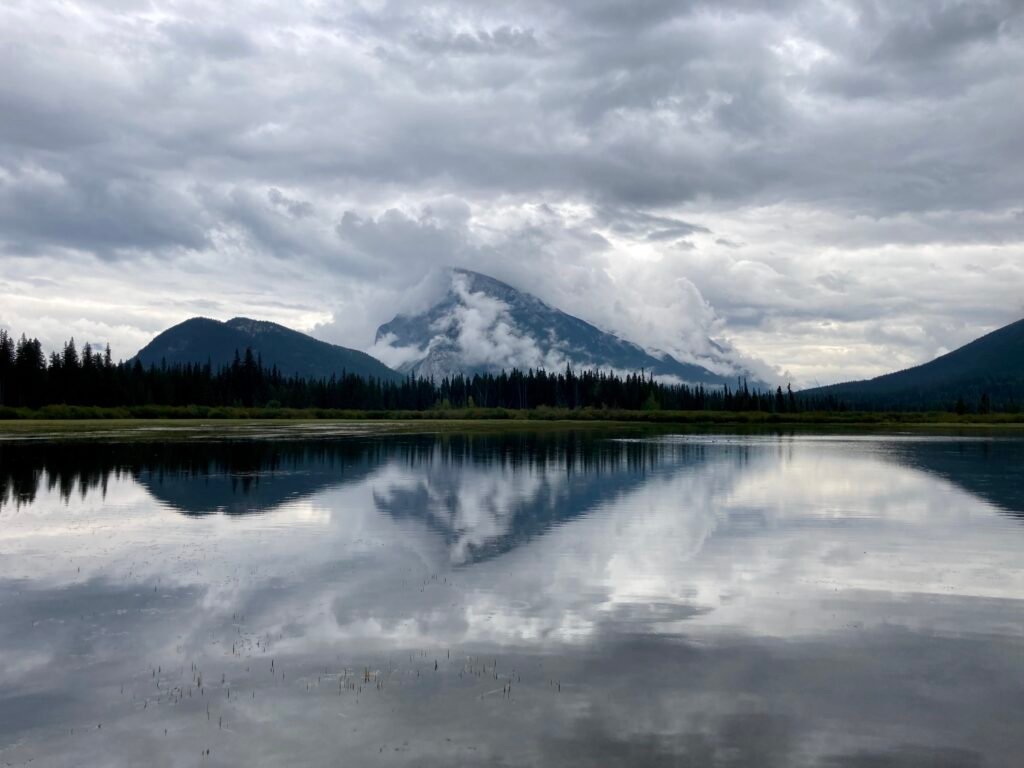
Evening
We wrapped up the day with a relaxing homemade dinner at our Airbnb, followed by a leisurely evening stroll through the quaint Canmore town center.
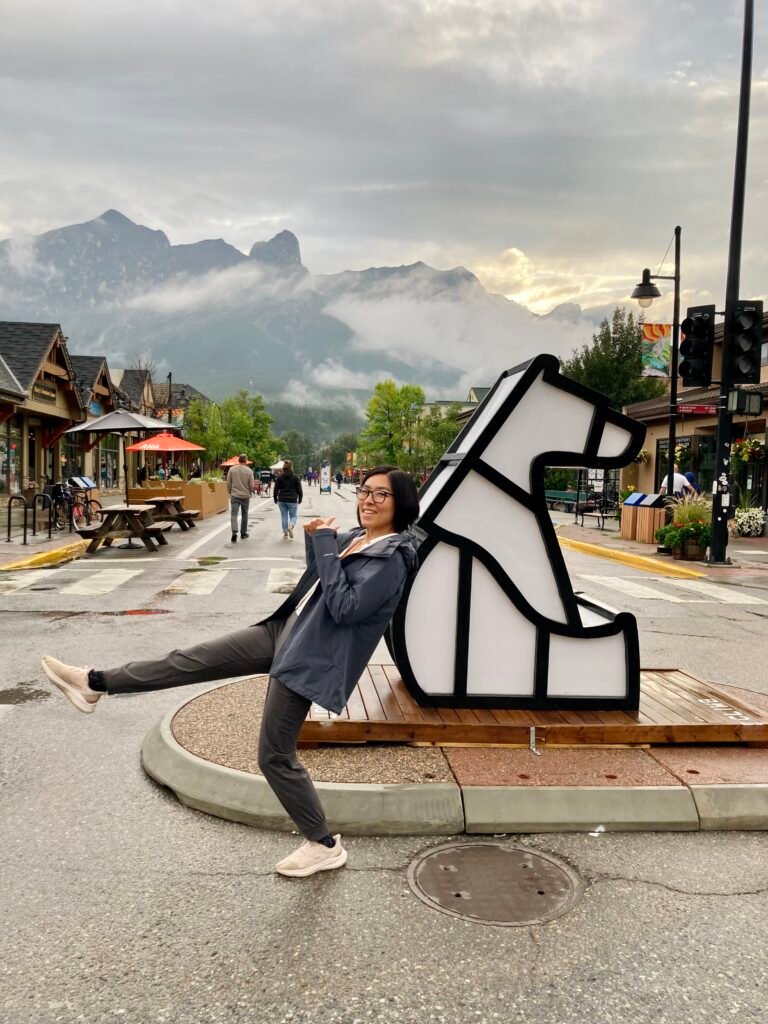
Day 2: Banff Gondola and Johnston Canyon
Highlights: Banff Gondola, Johnston Canyon, Scenic viewpoints.
Morning:
We started our first full day with a ride on the Banff Gondola, which whisked us to the summit of Sulphur Mountain. The boardwalk at the top offered panoramic views of Banff and the surrounding peaks. The cool mountain breeze made layering essential, but the breathtaking vistas were well worth it.
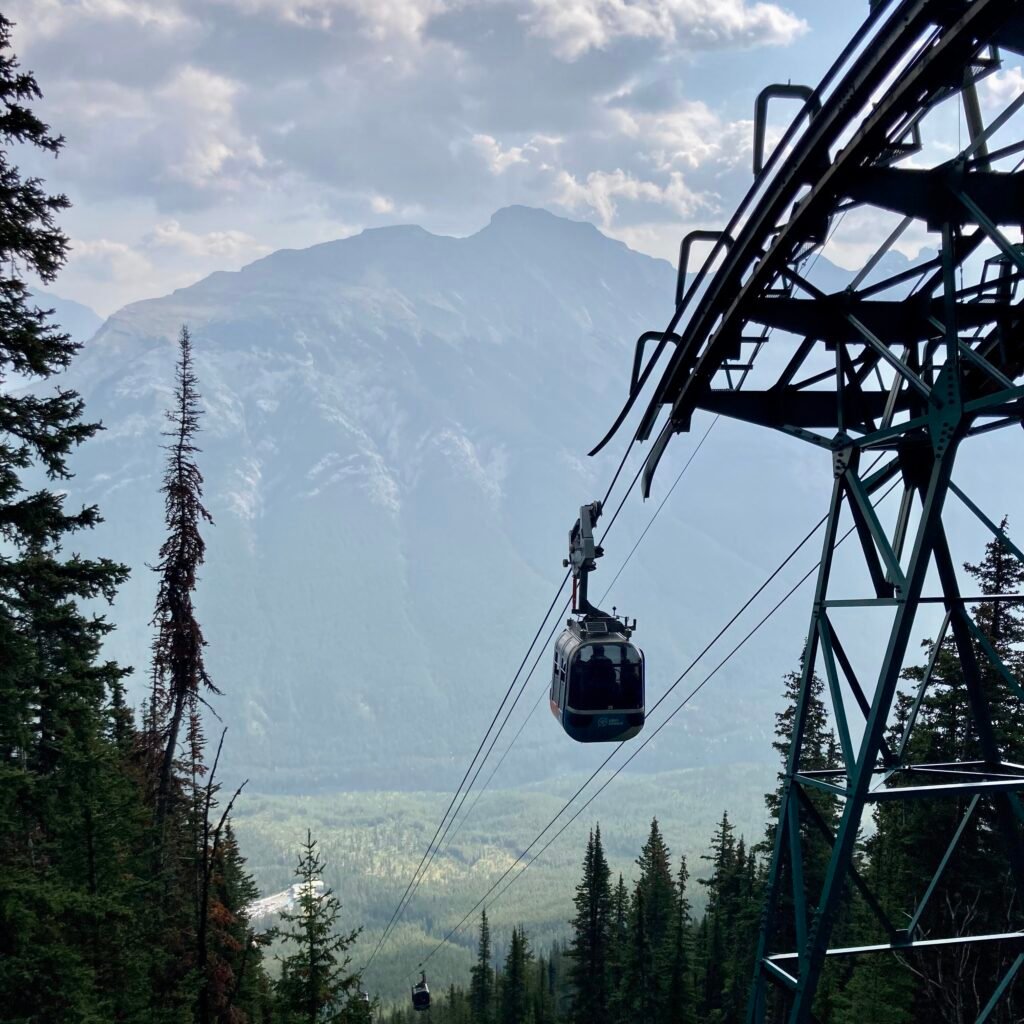

Afternoon:
After descending, we enjoyed lunch at Coyote Southwestern Grill, where the chili and burritos provided a comforting and satisfying boost. Refueled, we set off for Johnston Canyon, one of Banff National Park’s most popular and picturesque trails.
We chose the Johnston Canyon to Upper Falls Trail, a 3.3-mile round trip that’s moderately challenging yet incredibly rewarding. The trail winds through a breathtaking landscape shaped by water over thousands of years, beginning with an easy walk along well-maintained catwalks suspended above turquoise waters. These elevated pathways offered stunning views of cascading waterfalls and dramatic rock walls.
As we ventured deeper, the rushing water grew louder, and the lush forest surrounding the trail created a tranquil, almost magical atmosphere. The highlight was reaching the Upper Falls, where a powerful torrent plunges into the canyon, sending up a refreshing mist. Multiple viewpoints along the way showcased the canyon’s beauty from different angles, making this hike a must for nature lovers exploring Banff!



Evening:
We returned to Banff and visited a few scenic viewpoints before sun set, including the Hoodoos Viewpoint, Bow Falls Viewpoint, and Surprise Corner Viewpoint, each offering unique perspectives of the park. Dinner at Castello Italiana in the Fairmont Banff Springs Hotel was a standout, featuring indulgent dishes like mushroom pasta, steelhead trout, and panna cotta.


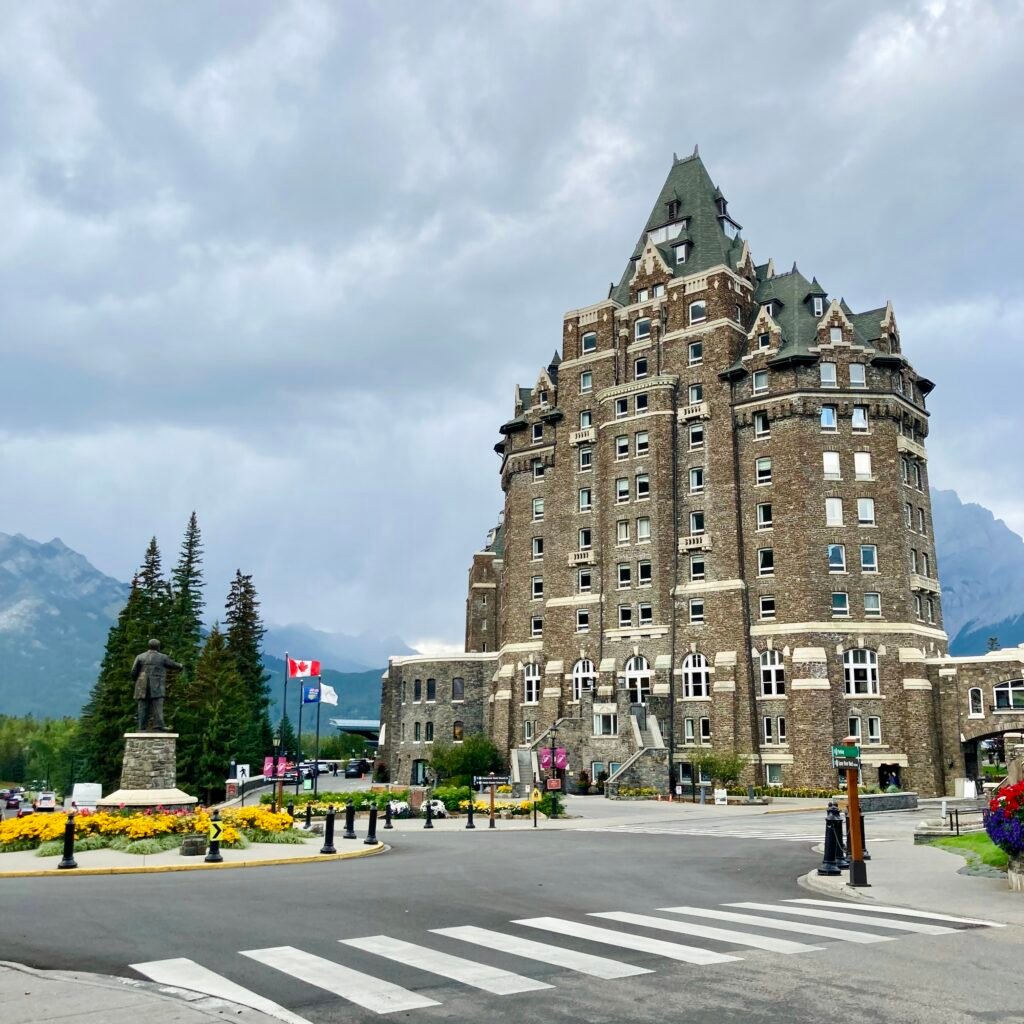
Day 3: Lake Minnewanka and Grassi Lakes
Highlights: Lake Minnetonka, Bankhead, Grassi Lakes.
Morning:
We started our day at Lake Minnewanka, embarking on a relaxing one-hour boat cruise that offered stunning views of the lake and its surrounding mountains. Afterward, we took a leisurely hike along the Stewart Canyon Trail (1.1 miles, easy), where peaceful lakeside views provided a serene escape.
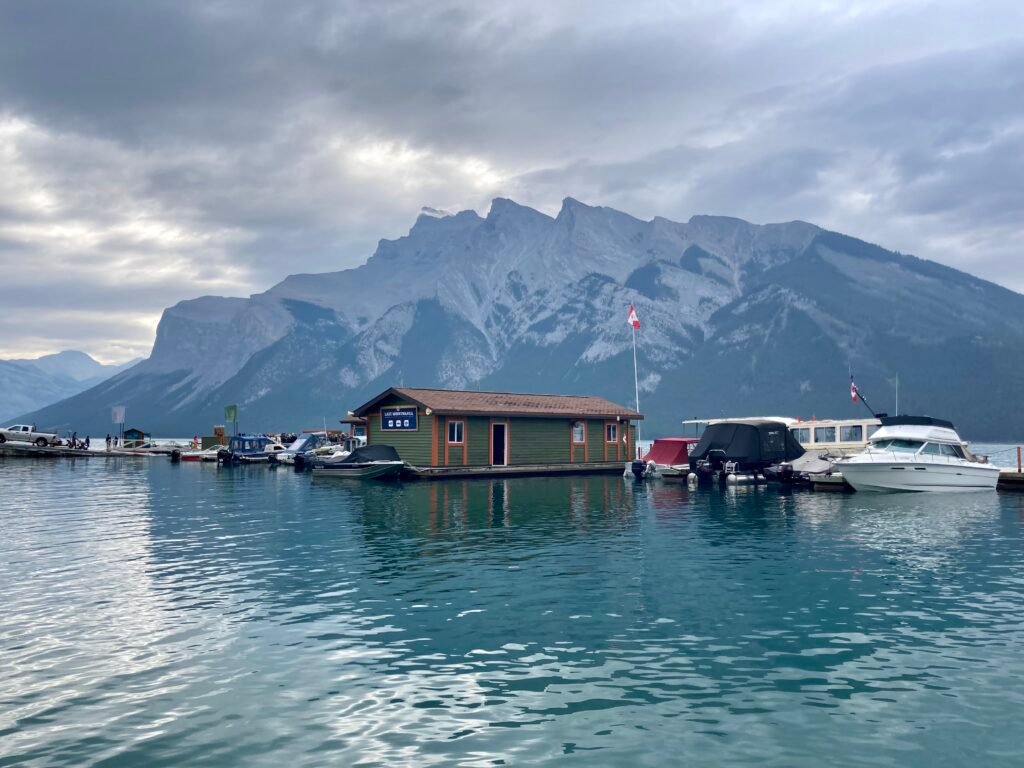
Next, we made a quick stop at the nearby Two Jack Lake, a tranquil spot perfect for enjoying a scenic snack while soaking in the beauty of the Rockies.
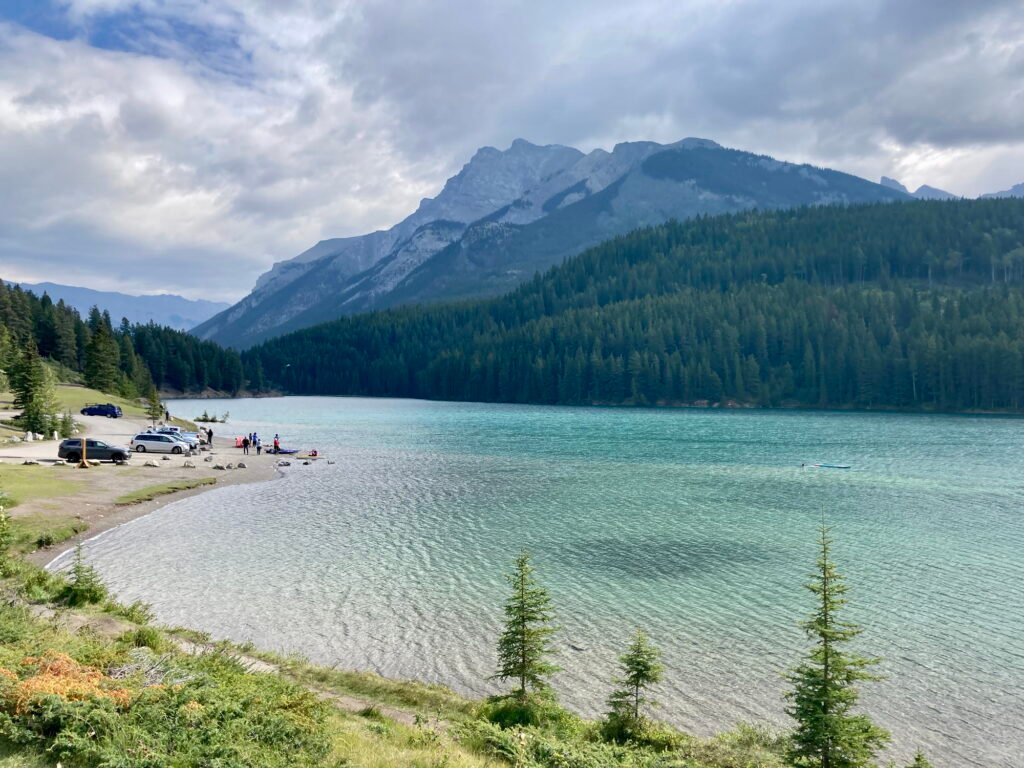
Our journey continued to Bankhead, a historic coal mining site. Here, we walked the Bankhead Interpretative Trail (0.7-mile loop, easy), where well-placed signs brought the area’s industrial past to life, offering fascinating insights into its history.

Afternoon:
Back in Canmore, we enjoyed lunch at Ramen Arashi, a local favorite known for its authentic and flavorful Japanese ramen. With our energy restored, we set off to hike the Grassi Lakes Trail, a 2.1-mile loop that’s moderately challenging but absolutely worth every step!
We ascended via the Upper Trail, which led us through a serene pine forest, where the scent of evergreens and the rustling of leaves created a tranquil atmosphere. The trail’s highlight was reaching the Grassi Lakes, two stunningly layered lakes with water so vividly green it felt almost otherworldly. The lakes’ crystal-clear reflections of the surrounding cliffs and sky added to their magical charm, making it a truly mesmerizing sight. Unlike the more tourist-heavy attractions in Banff, Grassi Lakes felt like a hidden gem with a quieter, more local vibe, which only enhanced the experience.
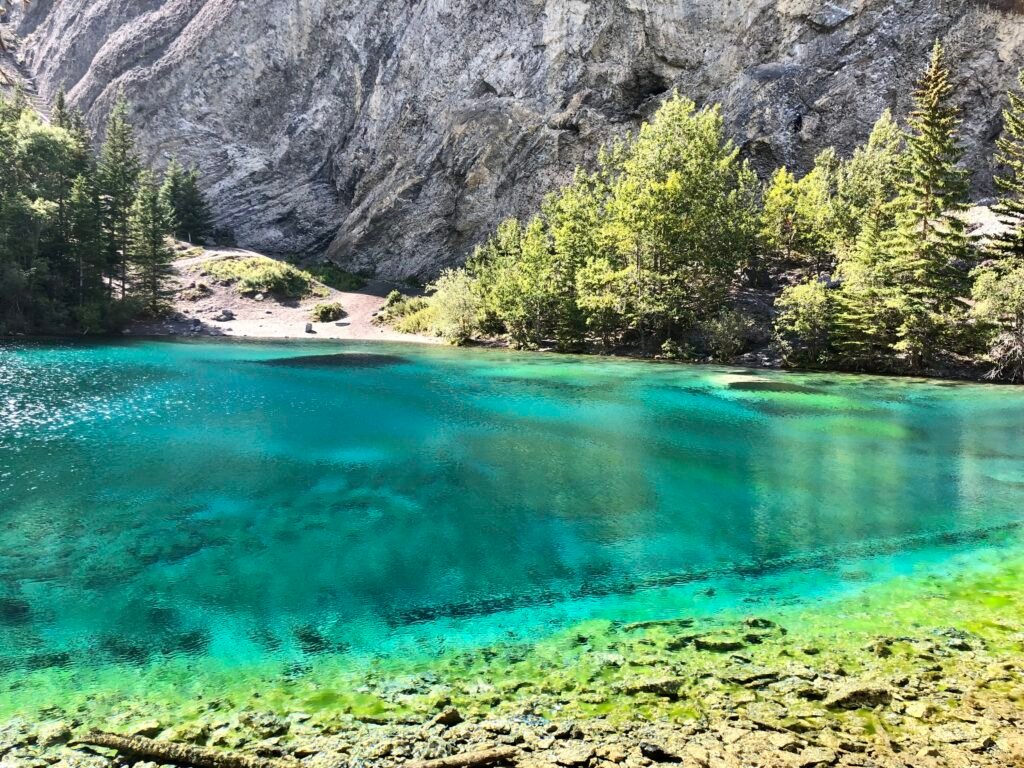

For the descent, we took the Interpretative Trail, which rewarded us with sweeping views of the Bow River, the majestic Rocky Mountains, and the cascading Grassi Lake Waterfalls. The combination of peaceful trails, breathtaking views, and vibrant lakes made this hike an unforgettable part of our journey.

Evening:
After grocery shopping, we had a relaxing homemade dinner at our Airbnb and ended the day with a gentle walk along the Bow River Loop Trail (1.3 miles, easy).

Day 4: Moraine Lake and Emerald Lake
Highlights: Bow Valley Parkway, Moraine Lake, Emerald Lake.
Morning:
We started the day with fresh artisan croissants from Le Fournil Bakery, checked out of our Airbnb, and drove to Moraine Lake (1hr away). The scenic drive along the Bow Valley Parkway was a highlight, with stops at Castle Cliff Viewpoint and Morant’s Curve for breathtaking views.
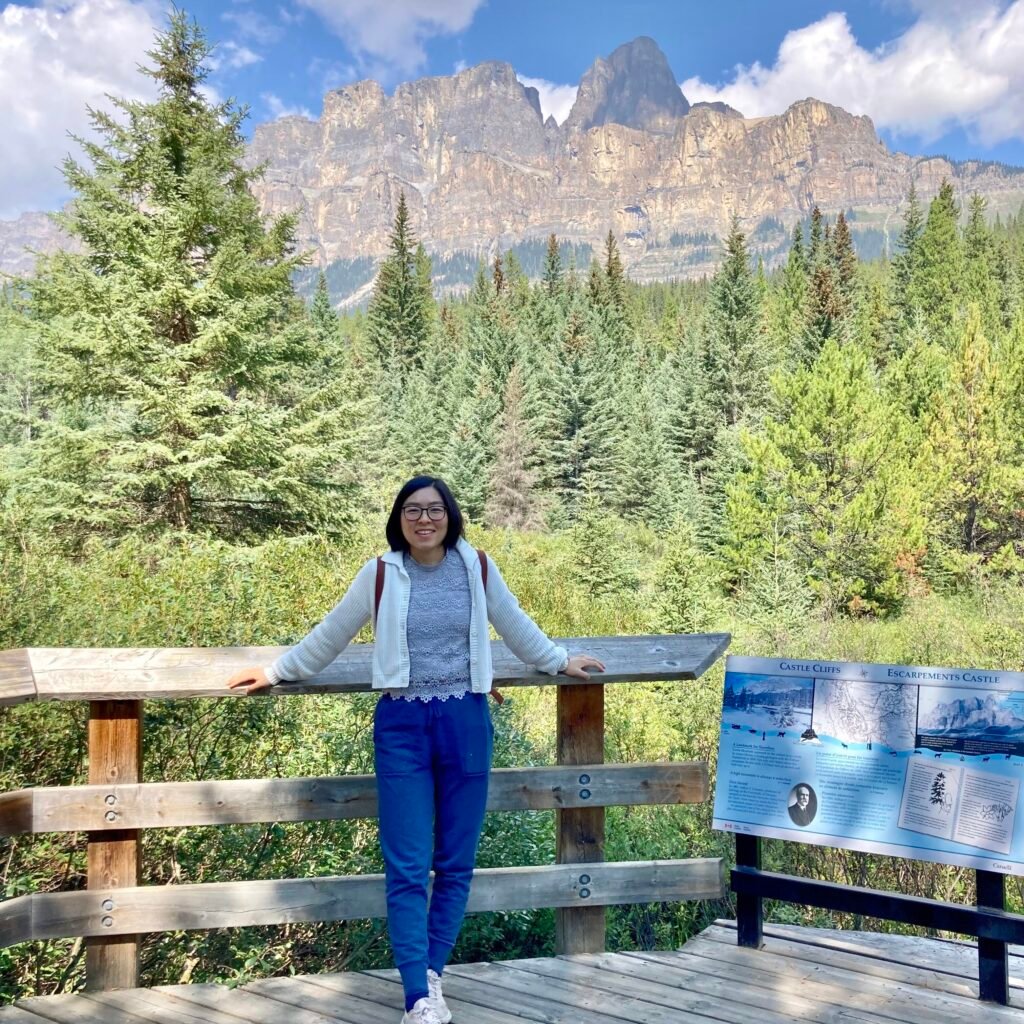

Upon arriving at Moraine Lake, we were immediately captivated by its surreal beauty. Often considered one of the most breathtaking lakes in the world, Moraine Lake’s vibrant turquoise waters are surrounded by towering peaks and lush forests, creating a scene that feels almost too perfect to be real. The lake owes its stunning color to glacial runoff that carries fine rock flour, reflecting light to create the iconic hue. It’s no wonder Moraine Lake is so cherished—it’s even featured on Canada’s $20 bill as a symbol of the country’s natural splendor.
We began our visit with the Rockpile Trail (0.6 miles, easy), which led us to an elevated viewpoint offering postcard-perfect panoramas of the lake and the Valley of the Ten Peaks. Next, we strolled along the Lakeshore Trail (3.5 miles, easy), a peaceful path that allowed us to experience the lake’s beauty from multiple perspectives and appreciate its serene atmosphere.

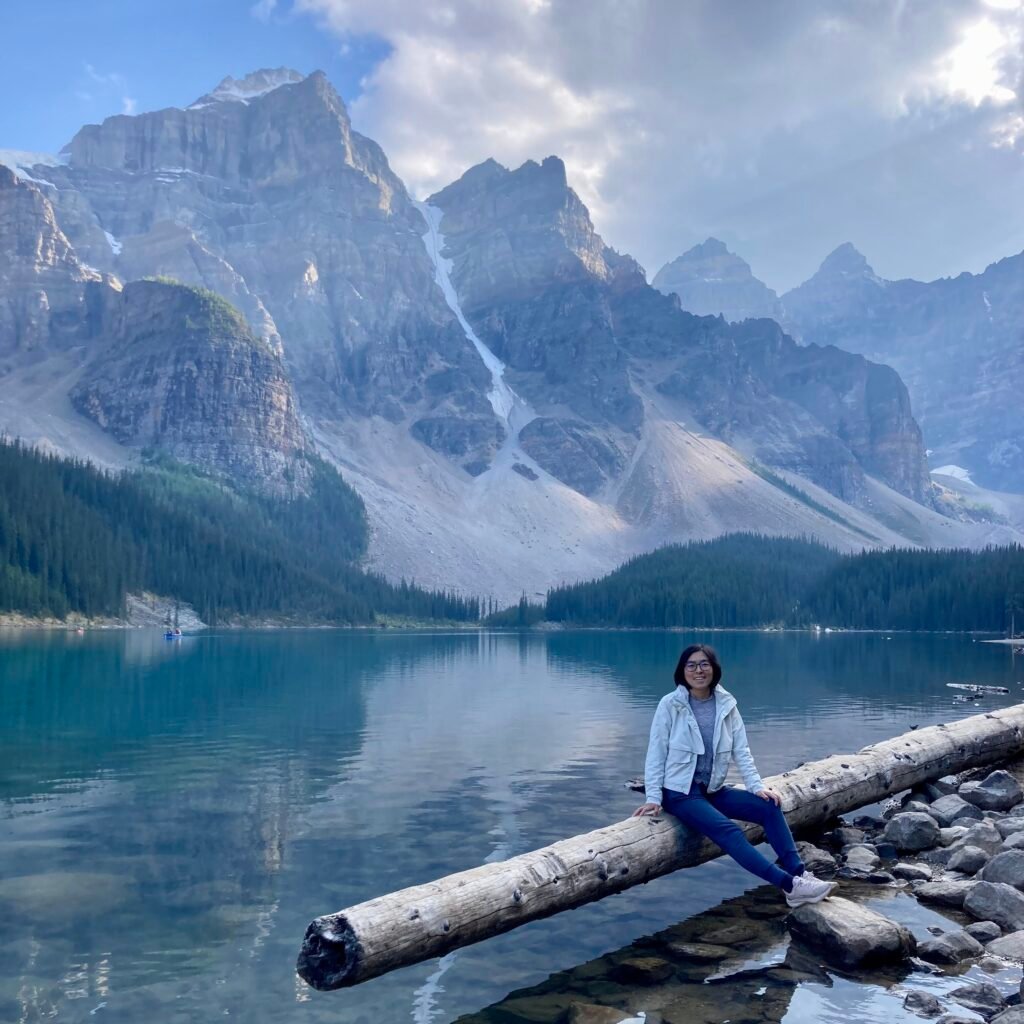
Afternoon:
After our hike, we returned to Lake Louise Village and enjoyed a quick lunch at Trailhead Cafe, known for its fresh sandwiches and baked goods. Refueled and ready to relax, we checked into Paradise Lodge & Bungalows, a charming retreat offering cozy log cabins, a serene atmosphere, and a mid-range budget-friendly option. For those looking to indulge, the luxurious Fairmont Château Lake Louise, with its iconic lakeside views and world-class amenities, is an excellent alternative.
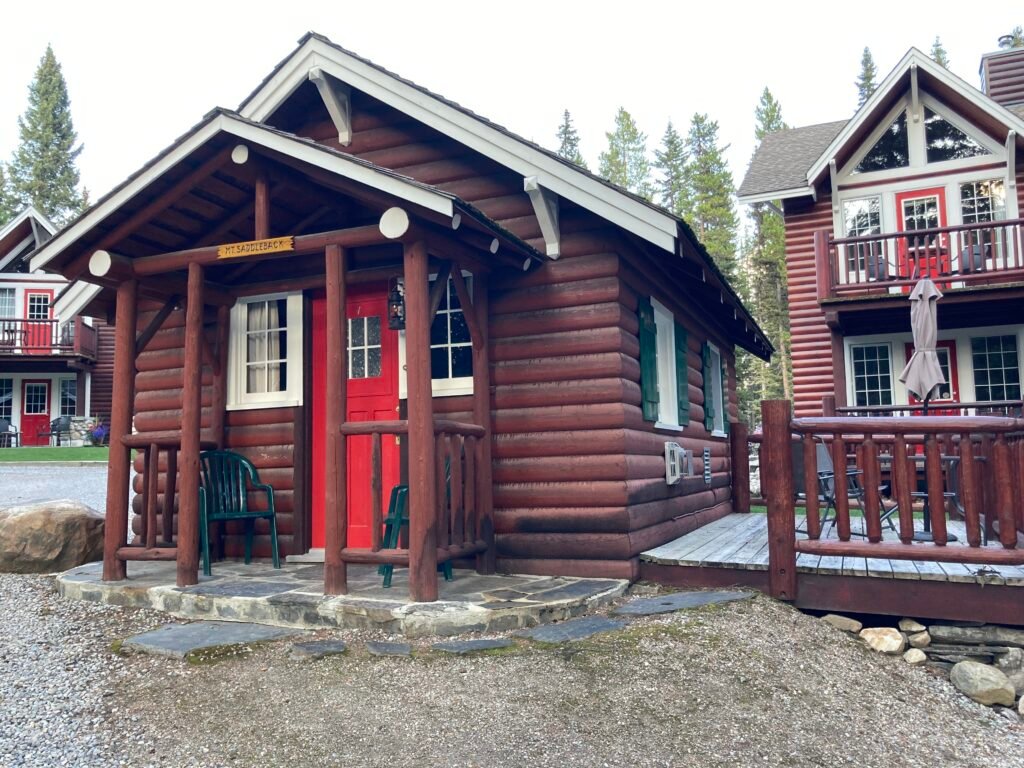
Once settled, we made our way to Emerald Lake (30mins drive) for a leisurely kayaking experience. Surrounded by lush forests and towering mountains, the lake’s vivid green waters shimmered in the afternoon light, creating a tranquil and otherworldly escape. Paddling across its calm surface was the perfect way to unwind and immerse ourselves in the serene beauty of the Canadian Rockies.
Evening:
We wrapped up the day with a satisfying dinner at Bill Peyto’s Cafe, a cozy spot known for its hearty burgers.

Practical Tips for Visiting Moraine Lake:
To preserve its fragile ecosystem and reduce traffic congestion, private vehicles are not allowed to drive directly to Moraine Lake. Visitors must reserve a timed shuttle bus online in advance, as spots fill up quickly, especially during peak summer months. We parked at the Park & Ride Shuttle lot at the Lake Louise Ski Resort, from where the shuttle service efficiently transported us to the lake. Plan your visit early in the day or late in the afternoon for fewer crowds and optimal lighting for photos. These small preparations ensure you’ll have a stress-free visit to one of Banff’s most iconic landmarks.
Day 5: Lake Louise to Columbia Glacier
Highlights: Lake Louise, Lake Agnes Tea House Trail, Icefields Parkway, Athabasca Glacier.
Morning:

We began our day at Lake Louise, another iconic and breathtaking lake in Banff National Park that’s often celebrated as one of the most beautiful in the world. Standing at its shoreline, we were captivated by its vivid turquoise waters, framed by rugged mountains and majestic glaciers. The scene felt like a portal to an enchanted world hidden beyond the towering peaks—absolutely magical and unforgettable.
When we visited, the area was shrouded in smoke from nearby wildfires, which reduced visibility. Yet, even under a hazy sky, Lake Louise retained its extraordinary beauty, leaving us deeply impressed by its timeless charm.
Hiking to Lake Agnes and Beyond:
The highlight of our visit was undoubtedly the Lake Agnes Tea House Trail (4.6 miles, moderately challenging), a hike that delivered breathtaking alpine views at every turn. The trail wove through dense forest and opened up to reveal serene moments of natural beauty, each more rewarding than the last.
Arriving at the historic Lake Agnes Tea House, perched beside its namesake lake, felt like stepping into a mountain oasis. The brisk, refreshing air combined with the comforting aroma of freshly brewed tea created an atmosphere of pure tranquility. Sipping from a traditional teapot, we savored every moment as we gazed out over the crystal-clear waters of Lake Agnes, framed by towering peaks. This simple yet profound experience—enjoying a steaming cup of fragrant tea after a rewarding hike—left us feeling deeply grateful and content.

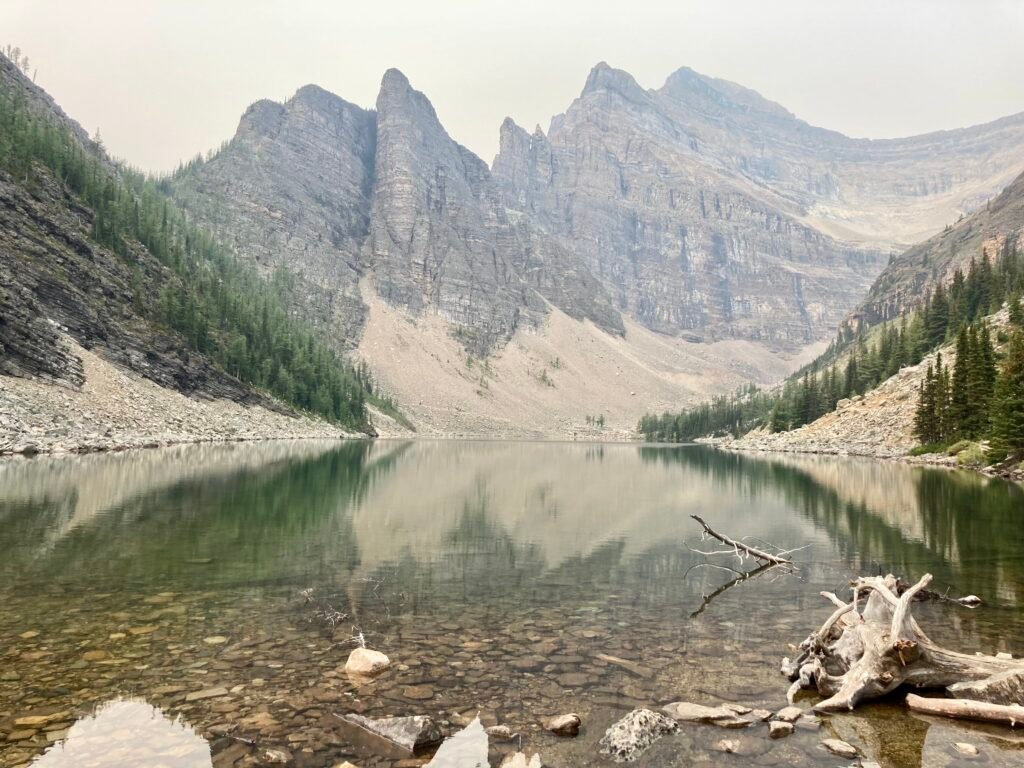
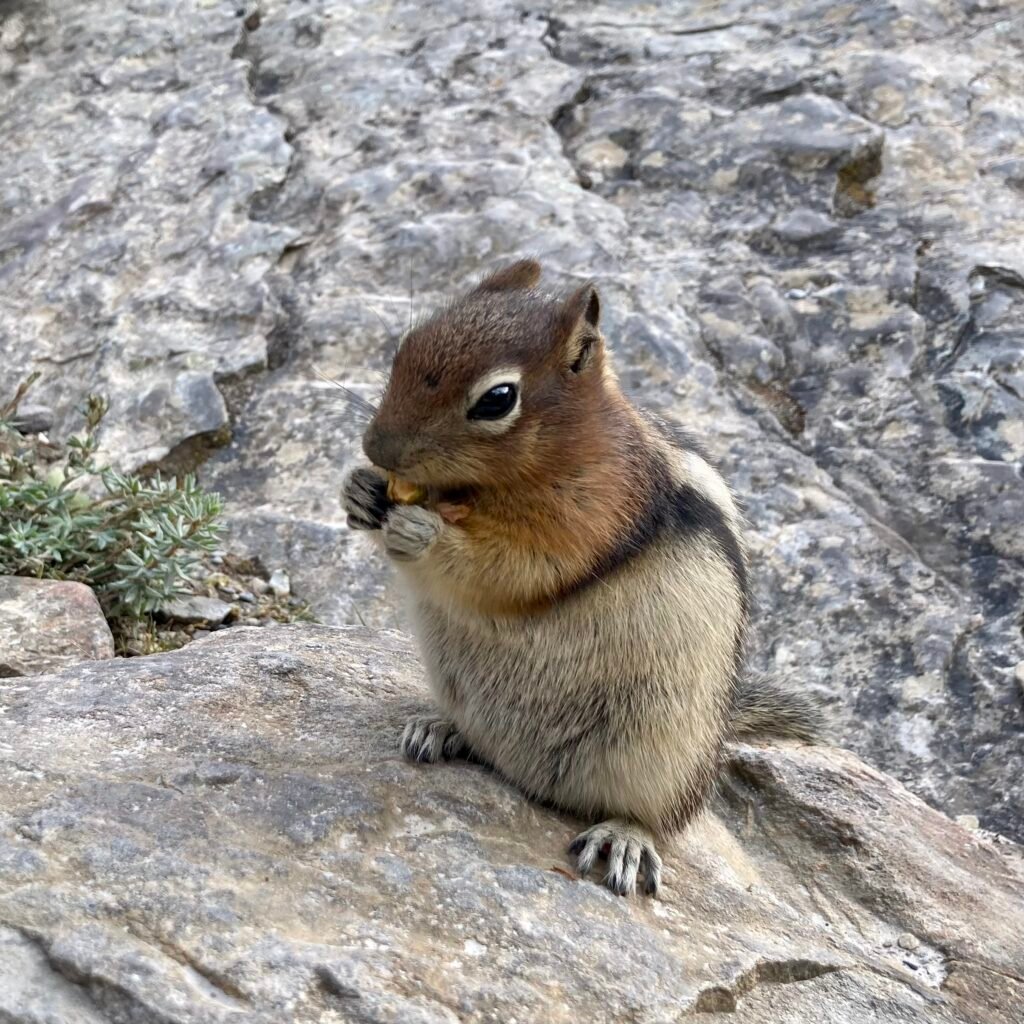
On our way down, we took an unforgettable detour to the Plain of Six Glaciers Trail, adding an extra layer of magic to an already rewarding hike. From the Mirror Lake junction, we turned right and walked about 0.5 miles, where a few hidden openings on the left revealed breathtaking panoramic views of Lake Louise from above.
The aerial perspective showcased the lake’s surreal turquoise hue, surrounded by rugged peaks and glaciers, creating a scene that felt almost otherworldly. The sight of the Fairmont Château Lake Louise nestled at the water’s edge added a touch of elegance, making the entire view look like a scene from a fairytale.
This short detour is an absolute must for anyone hiking the Lake Agnes Tea House Trail, offering unparalleled vistas that elevate the experience to extraordinary. It’s the perfect way to appreciate Lake Louise’s beauty from a completely different angle.

Afternoon:
After the hike, we treated ourselves to lunch at the Lakeview Lounge of Fairmont Château Lake Louise. As non-hotel guests, we joined the walk-in list and were fortunate to be seated with only a short wait. The setting was as delightful as the meal itself—smoked ahi tuna and prawn pasta that were as flavorful as they were elegantly presented. All the while, we soaked in the unbeatable view of Lake Louise framed by towering mountains and glaciers, a dining experience as memorable as the hike.
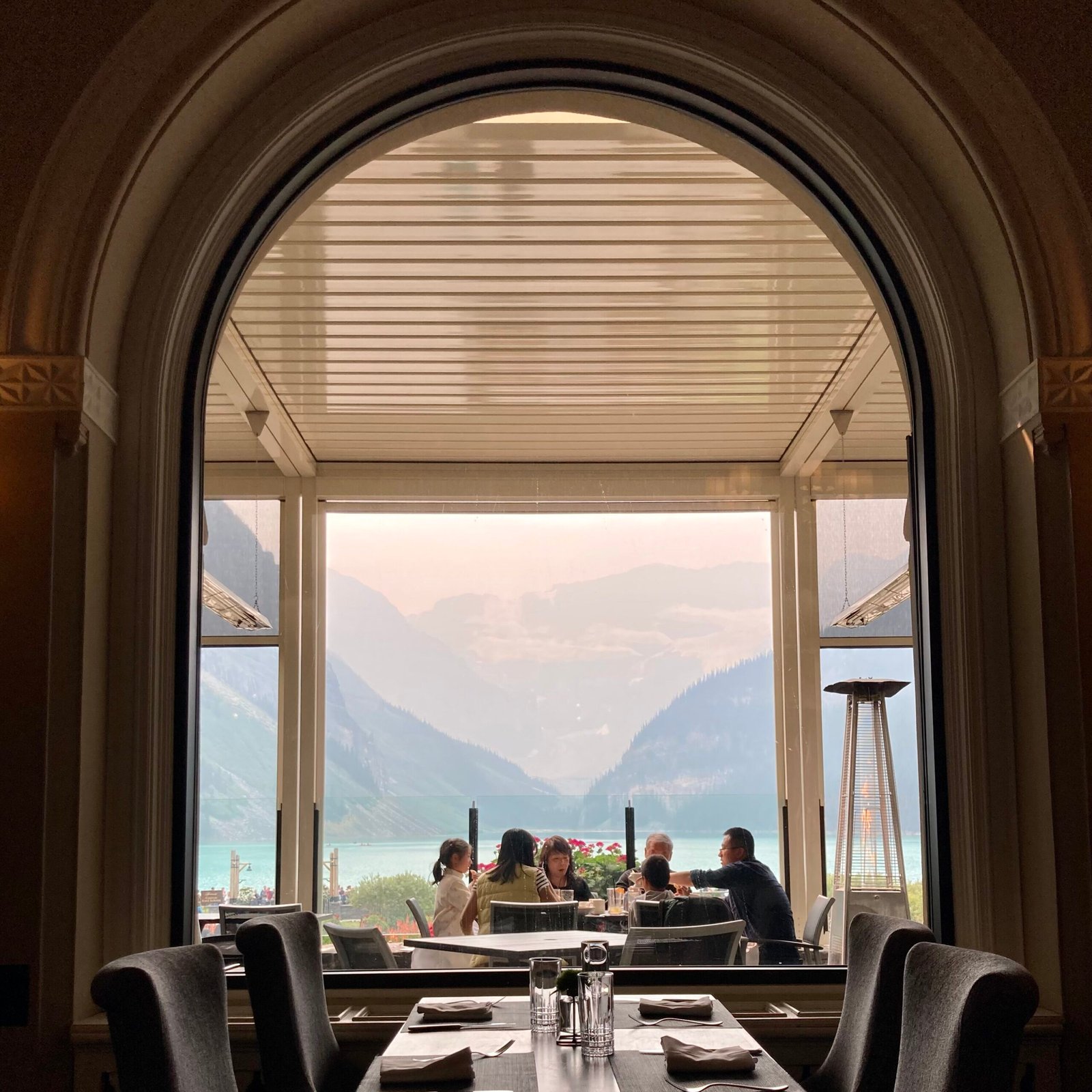

With our spirits and energy replenished, we set off along the Icefields Parkway, often hailed as one of the most scenic highways in the world, en route to the Columbia Icefield. Though the drive is dotted with breathtaking viewpoints, we opted to save most of these stops for our return trip the next day, ensuring a smoother journey and allowing us to focus on reaching our destination before dusk. The anticipation of revisiting these spots made the scenic drive all the more exciting.
Evening:
We chose the Glacier View Lodge as our base for the night, perfectly situated for exploring the Columbia Icefield the next day. Upon arrival and checking in, we were immediately drawn to the hotel’s stunning lodge area, featuring full-glass windows that showcased breathtaking views of the surrounding glaciers and rugged peaks—a perfect spot to unwind after a day of travel.
For dinner, we dined at Alpine Social, the lodge’s in-house restaurant and the primary dining option in the area. The meal included flavorful dishes like corn soup and poached salmon, a satisfying end to the day despite the slightly higher price point typical for this remote location.


Before the sun dipped behind the mountains, we ventured out for a short hike on the Toe of the Athabasca Glacier Trail (0.9 miles, easy). The glowing sunset hues reflecting off the glacier created a surreal and tranquil atmosphere, making it the perfect way to close out the evening. This peaceful moment was a reminder of the awe-inspiring beauty of the Canadian Rockies.

Practical Tips for Visiting Lake Louise
Parking at Lake Louise is notoriously difficult, especially during peak seasons, as the lot fills up quickly in the morning. To avoid the hassle, consider booking a shuttle service. Many local operators offer convenient shuttle services to Lake Louise. We booked with Lake Louise Inn and had a seamless experience. The shuttle was punctual, comfortable, and eliminated the stress of finding parking, allowing us to fully enjoy our visit. Be sure to reserve your shuttle in advance, as spots can fill up quickly, particularly during summer and holiday weekends.
Day 6: Columbia Icefield and Icefields Parkway
Highlights: Columbia Icefield Ice Explorer Tour, Icefields Parkway, Waterfowl Lakes, Peyto Lake, Bow Lake.
Morning:
Our morning began with a guided Columbia Icefield Ice Explorer Tour, an unforgettable experience. We boarded a massive, heavy-duty ice explorer vehicle that carried us up onto the ancient icefield. Standing on the glacier, surrounded by its immense expanse, was both humbling and bittersweet. On one hand, the sheer size and beauty of the icefield left us in awe of nature’s power and grandeur. On the other hand, learning about the devastating impact of climate change and seeing firsthand how much the ice has receded over the years was deeply heartbreaking. It was a powerful reminder of the urgency to protect these natural wonders for future generations.
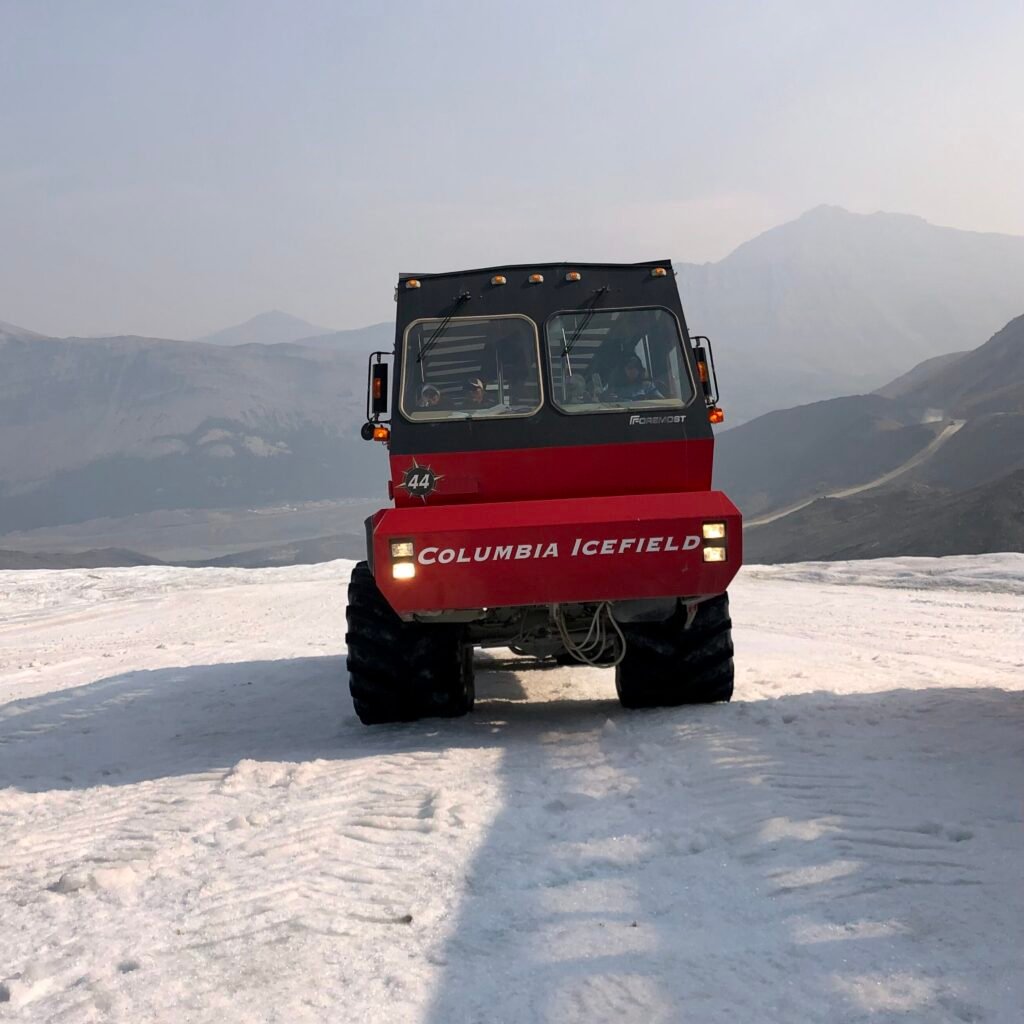

After returning to the visitor center, we drove a short distance to the Skywalk for a self-guided tour. This glass-floored walkway, perched high above the valley floor, offered breathtaking views of the glacier-fed landscape. From the Skywalk, we marveled at the distant glacier as it cascaded toward a shimmering lake, a scene that felt like a living postcard.
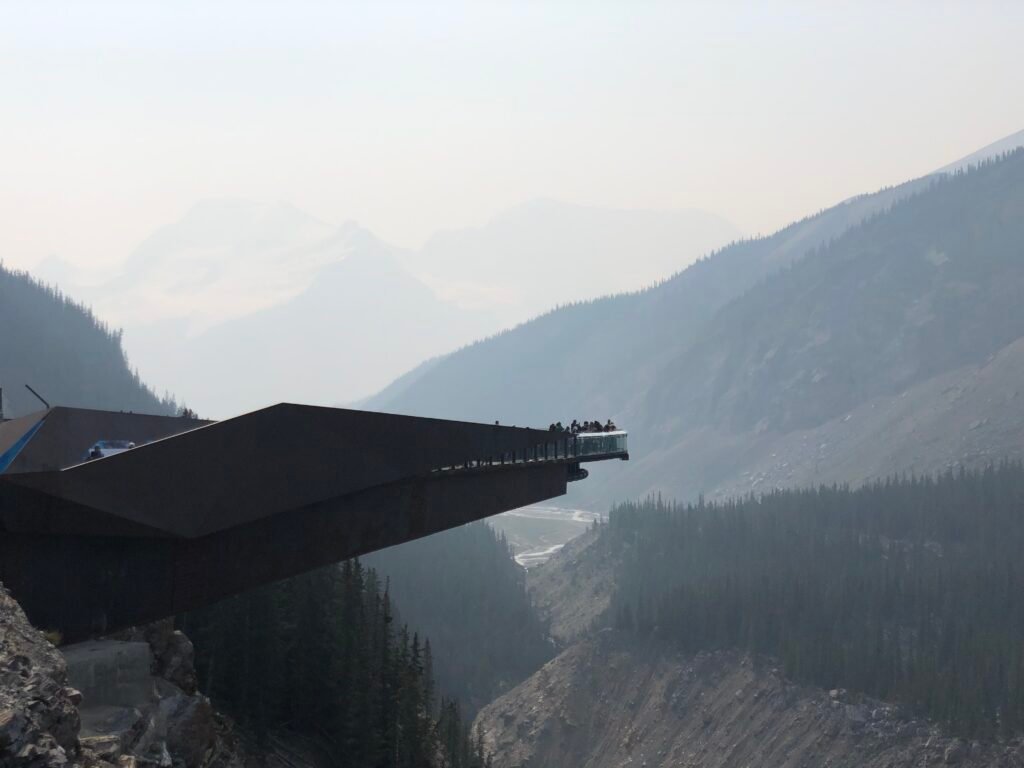
We wrapped up our visit with a quick lunch at the Columbia Icefield Visitor Center café. While the food was average and on the pricier side, it’s worth noting that dining options in this remote area are limited. Despite this, the unique experiences of the morning made it a day to remember.
Afternoon:
After lunch, we kicked off our return journey to Banff along the Icefields Parkway – an unforgettable exploration of some of the most stunning viewpoints in the Canadian Rockies. This world-famous highway is a treasure trove of natural beauty, and each stop revealed a new perspective of the park’s grandeur:
1. Weeping Wall Viewpoint:
A short drive further brought us to the Weeping Wall, a dramatic rock face where snowmelt cascades down in streams, resembling a wall of tears. This natural feature was both striking and serene.

2. Waterfowl Lakes Trail:
At the campground parking lot, we took a short 0.1-mile walk to a trail junction. From there, a 0.5-mile out-and-back leisure hike led us to the tranquil Upper or Lower Waterfowl Lakes, each offering vivid turquoise waters surrounded by alpine beauty.

3. Peyto Lake:
Next, we stopped at one of my favorite lakes in Banff National Park. A quick 0.6-mile walk to the viewpoint revealed the iconic wolf-shaped silhouette of Peyto Lake, glowing in its surreal turquoise hue. This view, framed by rugged peaks, felt like stepping into a dream.

4. Bow Lake:
At Bow Lake, we explored three distinct stops:
- Hanging Glacier Cafe: A cozy spot for coffee or snacks with a spectacular view of the lake and its two glaciers.
- Bow Lake Viewpoint: Conveniently located by the roadside, this offered an easy opportunity to admire the lake’s beauty.
- Bow Lake Day Use Area: From the picnic area parking lot, a short 0.2-mile trail brought us to a closer view of Bow Lake, with the Crowfoot Glacier serving as a stunning backdrop.
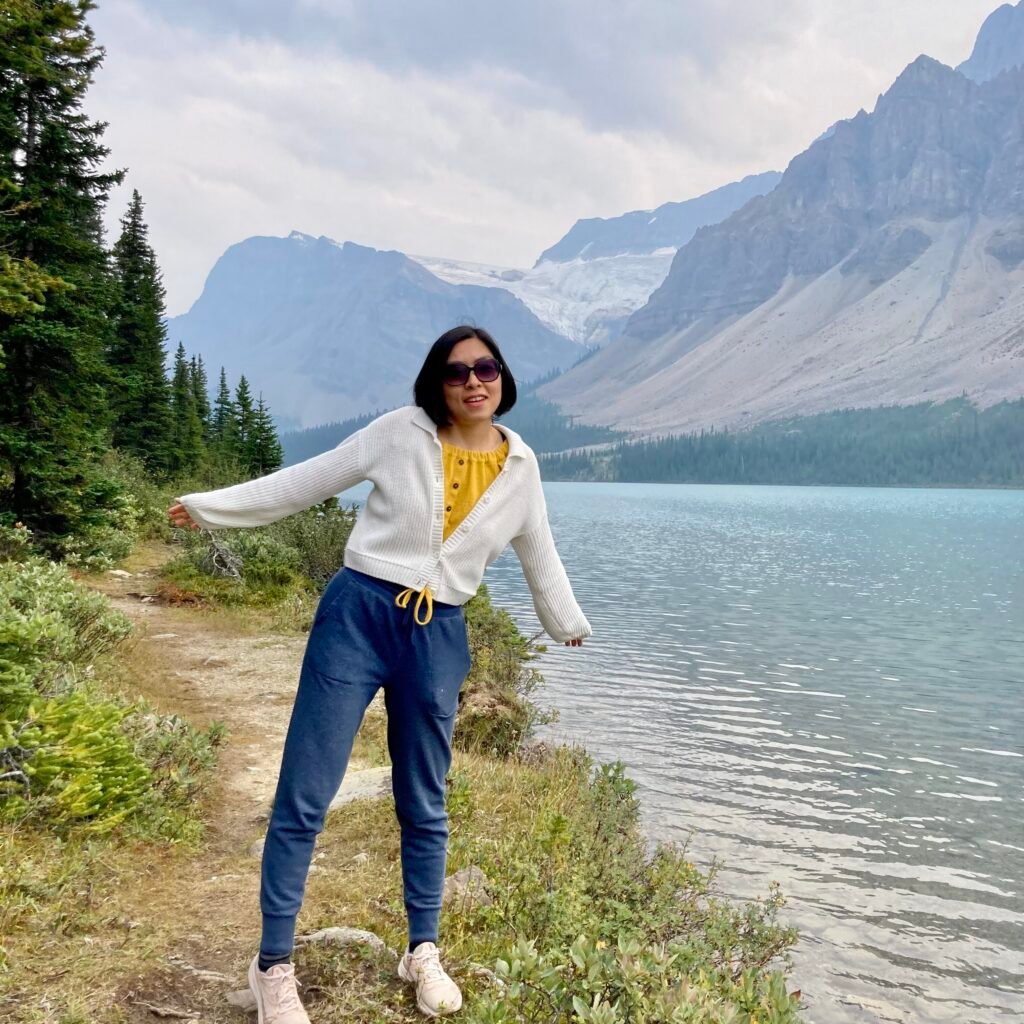
5. Crowfoot Glacier Viewpoint:
Our final stop was at the Crowfoot Glacier, named for its original three-pronged shape. Though only two “claws” remain due to melting, it still makes for a dramatic and humbling sight.
Each of the above stops along the Icefields Parkway offered its own unique charm and perspective, making this drive a continuous highlight of our trip.
Evening:
By evening, we arrived back in Banff Town and treated ourselves to dinner at Block Kitchen + Bar, a lively and welcoming spot known for its flavorful Asian fusion tapas. The creative dishes and vibrant atmosphere were the perfect way to wind down after a day of exploration. Afterward, we checked into our hotel, where we enjoyed a restful night, recharging for the adventures that lay ahead.

Day 7: Back to Calgary and Farewell
Highlights: Banff Town, Departure.
We savored a leisurely final morning in Banff Town, beginning with breakfast at Wild Flour Cafe, a cherished spot famed for its delicious baked goods and cozy, inviting atmosphere. After enjoying our meal, we took one last stroll through Banff Town, soaking in the final glimpses of the Rockies, their majestic peaks leaving an indelible mark on our hearts.

Reluctantly, we began our drive back to Calgary, reflecting on the unforgettable adventure that had unfolded over the past days.
If you have time for one last culinary treat before heading to the airport, Queen’s Breakfast Cocktail is a must-visit. Located conveniently near the Calgary International Airport, this spot serves up beautifully crafted dishes that are as delightful to the palate as they are to the eye. It was the perfect way to cap off our journey before boarding our flight home, our hearts brimming with memories of Banff’s unmatched beauty and magic.
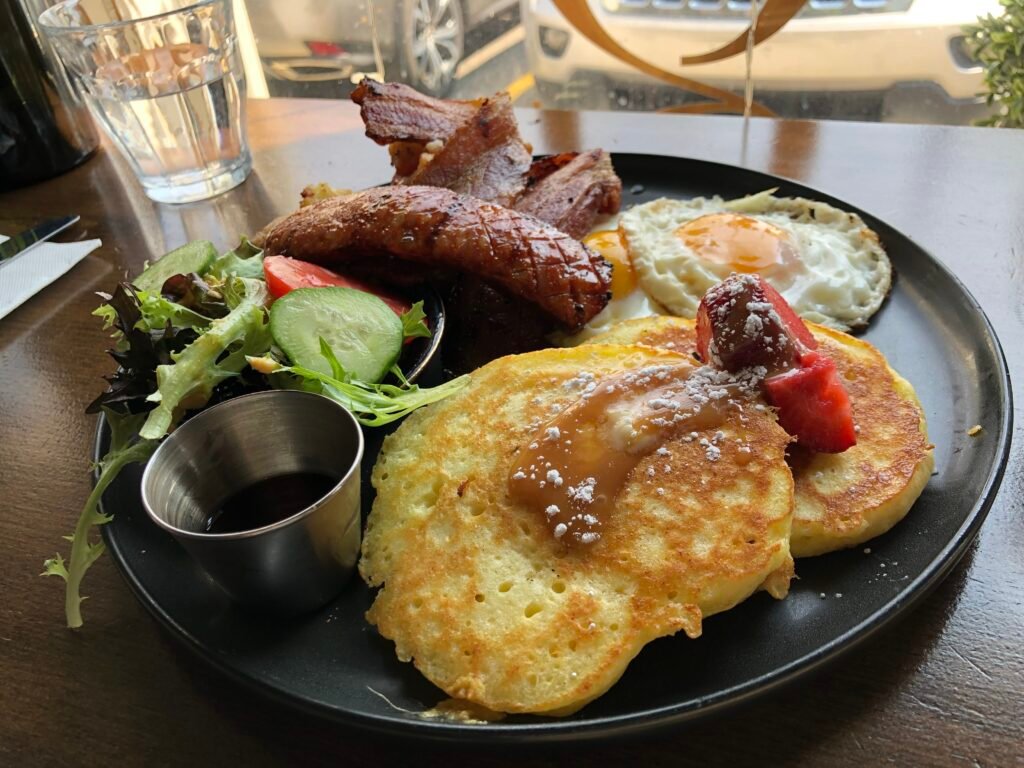
Other Tips for Your Banff Adventure
- Plan ahead: Banff is a popular destination, so it’s essential to book shuttles, activities, and accommodations in advance, especially for hotspots like Moraine Lake, Lake Louise, and the Columbia Icefield. Reserving early ensures you won’t miss out on these iconic experiences.
- Pack layers: Mountain weather can be highly unpredictable, with temperatures fluctuating quickly, particularly at higher elevations. Dressing in layers will keep you comfortable no matter what the day brings.
- Wear comfortable shoes: With so many incredible hiking trails and outdoor activities, sturdy, comfortable footwear is a must. Proper hiking shoes will make all the difference for enjoying Banff’s stunning landscapes.
These small preparations will help you make the most of your Banff adventure!
Banff: A Journey to Remember
Banff National Park is a destination that truly lives up to its reputation. From turquoise lakes and towering glaciers to charming alpine towns and unforgettable hiking trails, it offers an experience like no other. Whether you’re marveling at Moraine Lake’s surreal beauty, savoring tea at a mountaintop tea house, or driving along the world-renowned Icefields Parkway, every moment in Banff feels magical.
This 7-day Banff Road Trip barely scratches the surface of what Banff has to offer, but it’s enough to leave you awe-inspired and deeply connected to nature’s wonders. As we departed, our hearts were full of gratitude and memories that will last a lifetime. Banff isn’t just a place to visit—it’s a place that stays with you long after you’ve left. Start planning your trip today and discover this jewel of the Canadian Rockies!
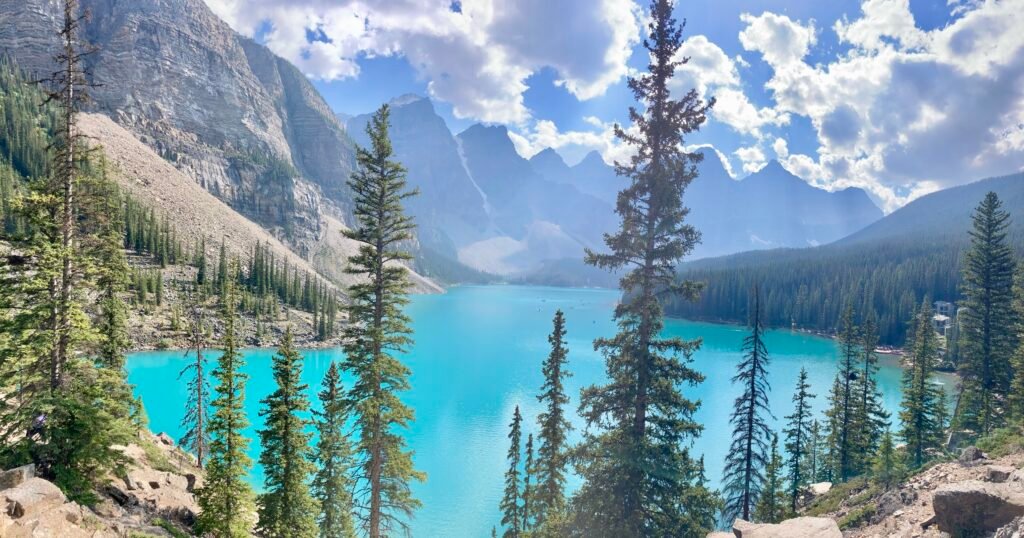
The End. Happy Traveling!
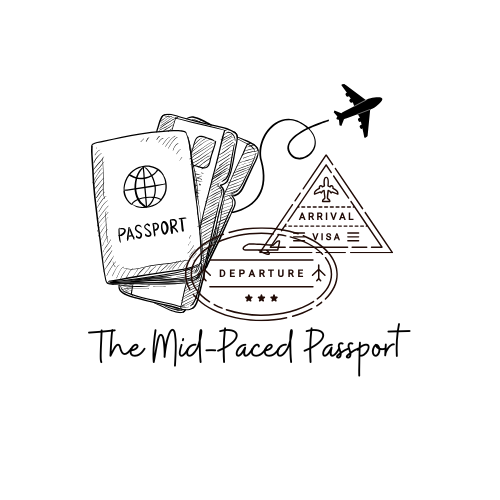
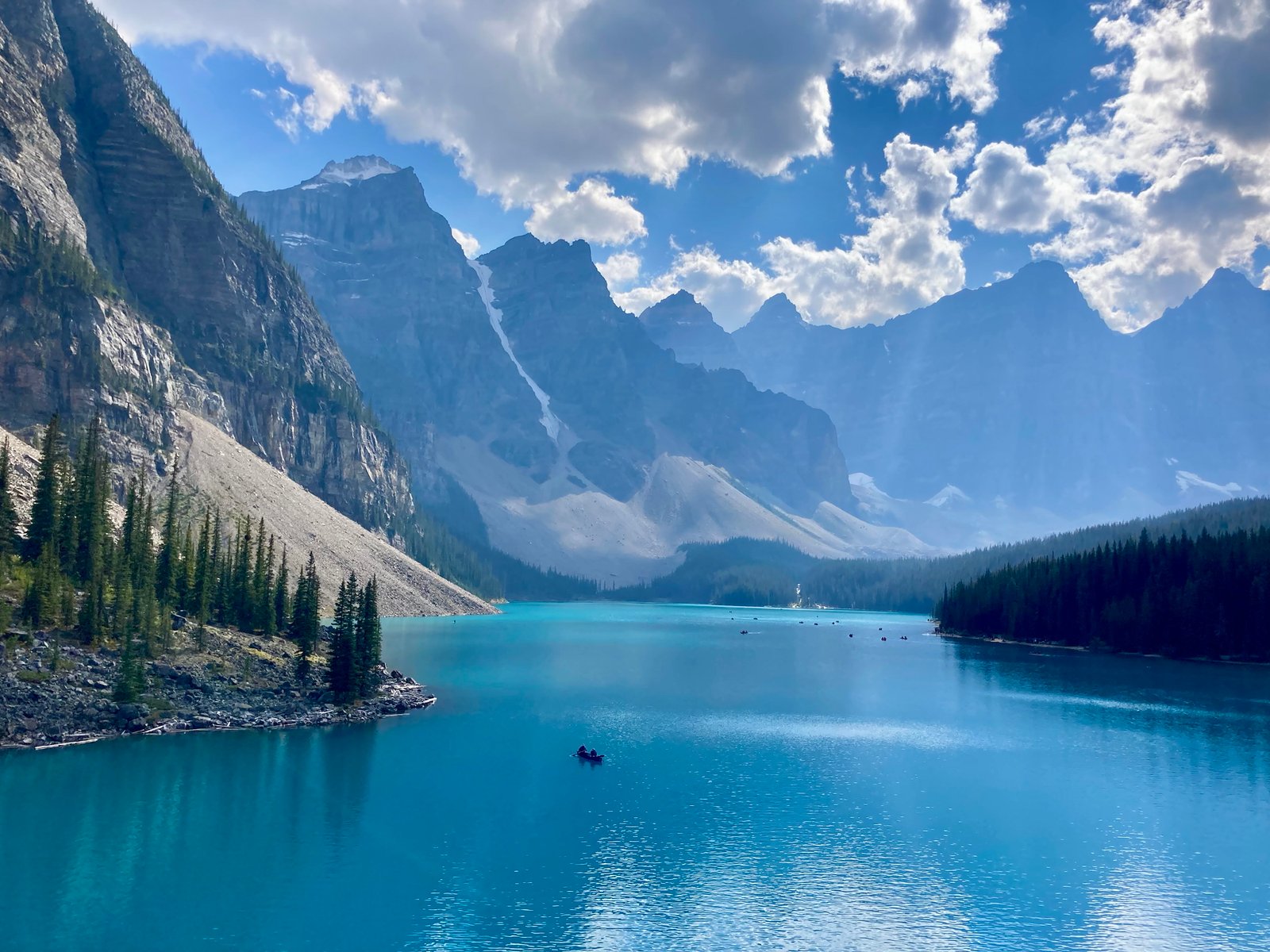


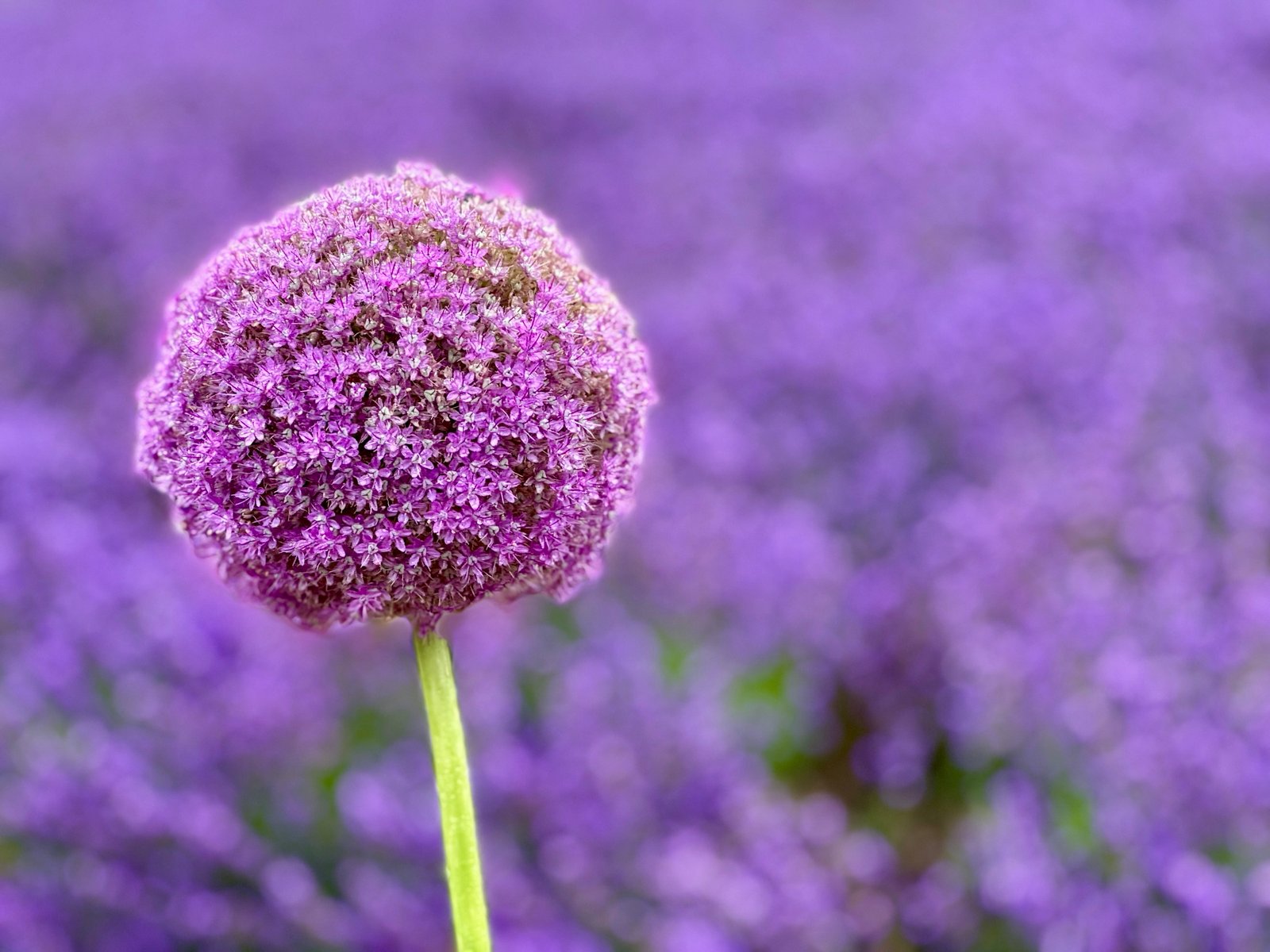

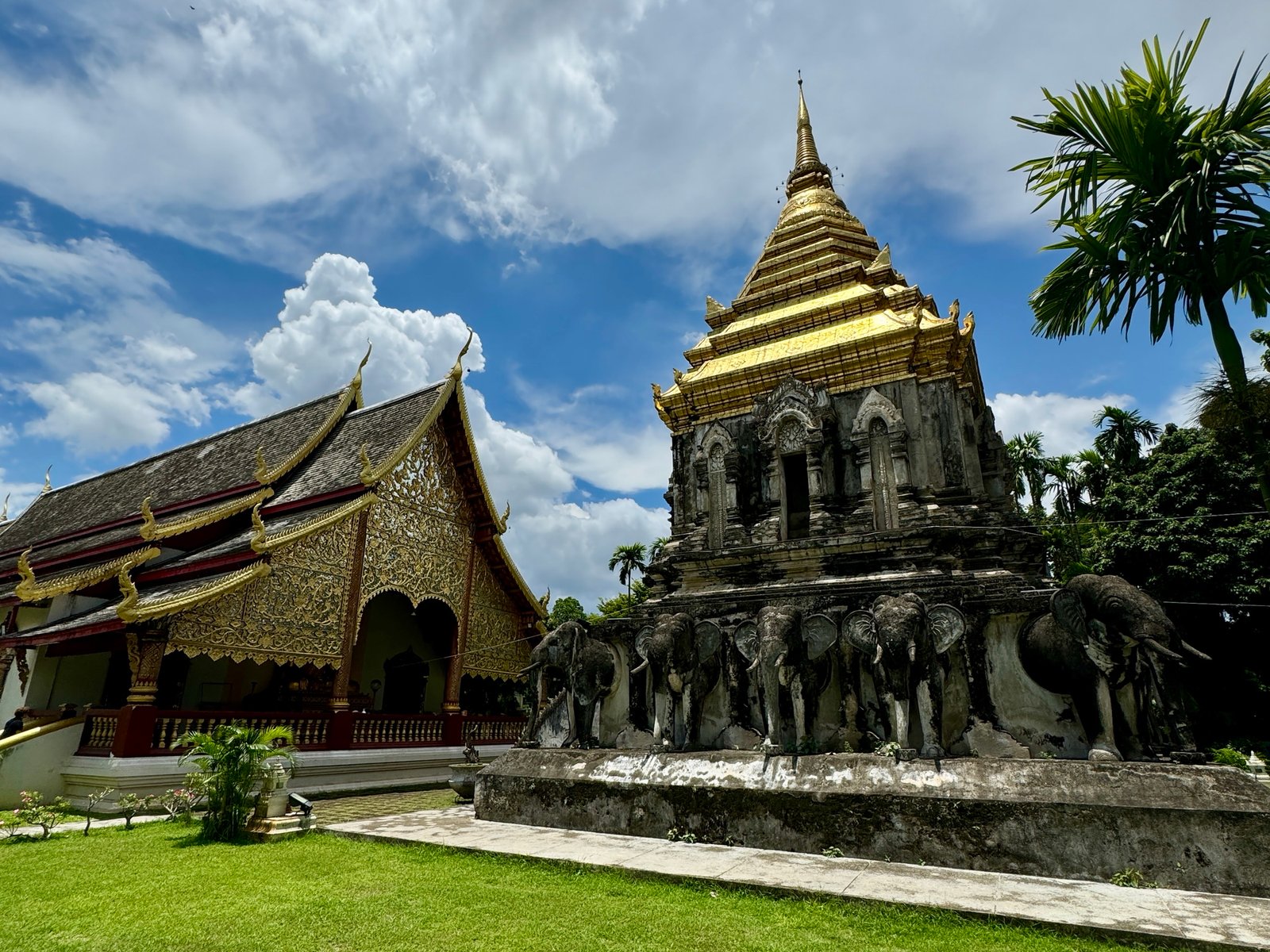
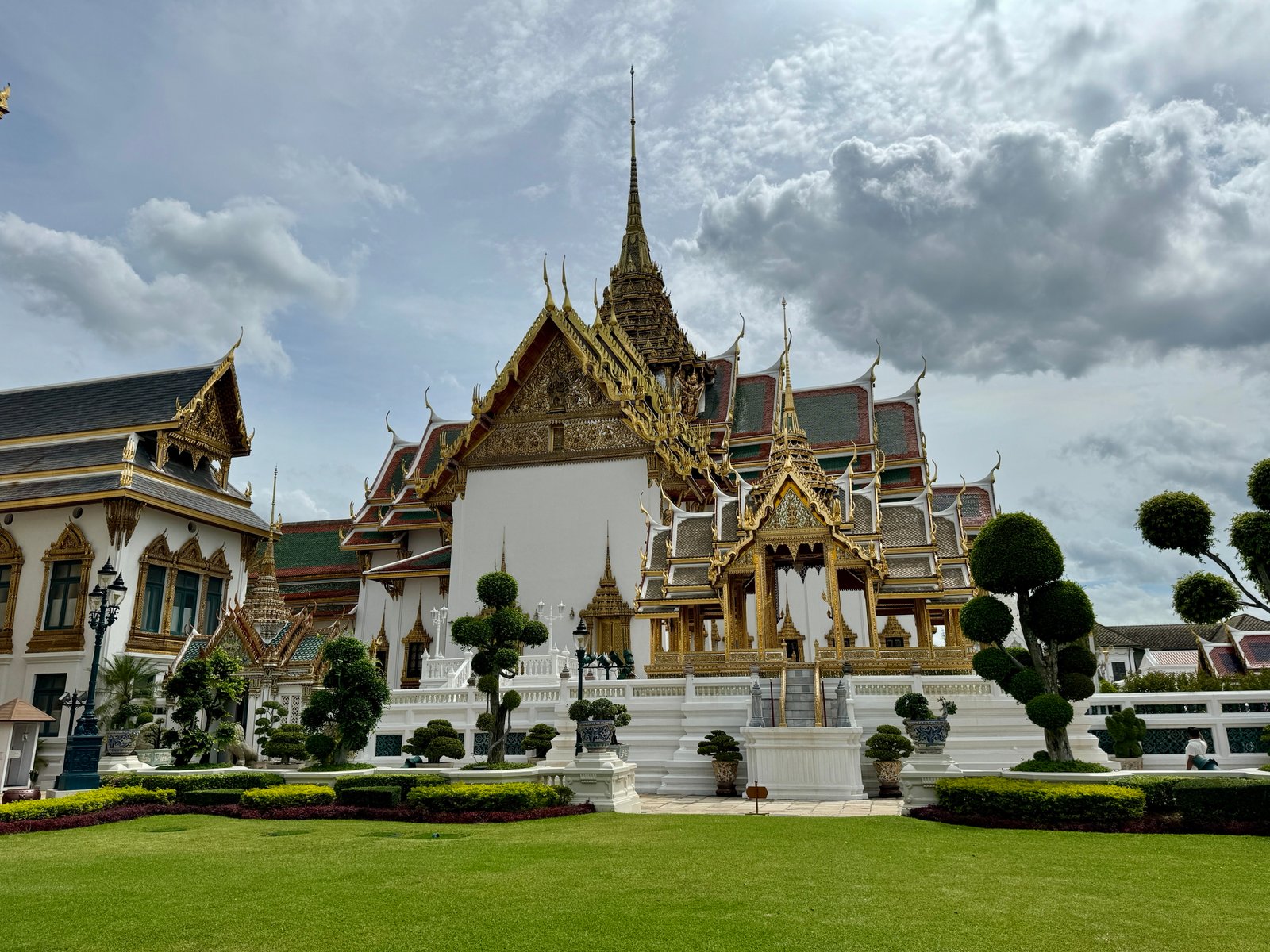
Leave a Reply